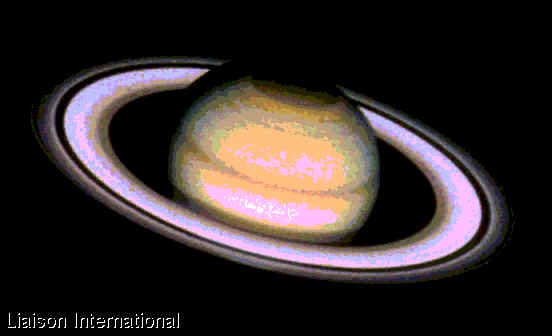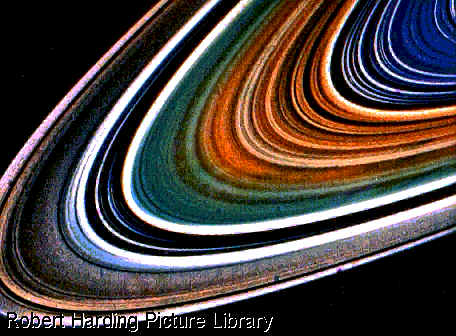|
|
|

Saturn, sixth planet in order of distance from the sun, and the second largest in the solar system. Saturn's most distinctive feature is its ring system, which was first seen in 1610 by Italian scientist Galileo, using one of the first telescopes. He did not understand that the rings were separate from the body of the planet, so he described them as handles (ansae).The Dutch astronomer Christiaan Huygens was the first to describe the rings correctly. In 1655, desiring further time to verify his explanation without losing his claim to priority, Huygens wrote a series of letters in code, which when properly arranged formed a Latin sentence that read in translation, "It is girdled by a thin flat ring, nowhere touching, inclined to the ecliptic." The rings are named in order of their discovery, and from the planet outward they are known as the D, C, B, A, F, G, and E rings. These rings are now known to comprise more than 100,000 individual ringlets, each of which circles the planet.
Exploration of the Saturnian System
As seen from earth, Saturn appears as a yellowish object—one of the brightest in the night sky. Observed through a telescope, the A and B rings are easily visible, whereas only under optimal conditions can the D and E rings be seen. Sensitive earth-based telescopes have detected nine satellites, and in the haze of Saturn's gaseous envelope, pale belts and zones parallel to the equator can be distinguished.
Three United States spacecraft have enormously increased knowledge of the Saturnian system. The Pioneer 11 (see Pioneer) probe flew by in September 1979, followed by Voyager 1 in November 1980 and Voyager 2 (see Voyager) in August 1981. These spacecraft carried cameras and instruments for analyzing the intensities and polarizations of radiation in the visible, ultraviolet, infrared, and radio portions of the electromagnetic spectrum (see Electromagnetic Radiation). The spacecraft were also equipped with instruments for studying magnetic fields and for detecting charged particles and interplanetary grains.
The National Aeronautics and Space Administration (NASA) plans to launch an orbiter called the Cassini spacecraft toward Saturn in late 1997. It should reach Saturn in 2004, when it will begin studying Saturn and its moons, launching a probe (the Huygens Probe) into the atmosphere of Saturn's moon Titan.
The Interior of Saturn
The mean density of Saturn is eight times less than that of Earth because the planet consists mainly of hydrogen. The enormous weight of Saturn's atmosphere causes the atmospheric pressure to increase rapidly toward the interior, where the hydrogen gas condenses into a liquid. Closer to the center of the planet, the liquid hydrogen is compressed into metallic hydrogen, which is an electrical conductor. Electrical currents in this metallic hydrogen are responsible for the planet's magnetic field. At the center of Saturn, heavy elements have probably settled into a small rocky core with a temperature close to 15,000° C (27,000° F). Both Jupiter and Saturn are still settling gravitationally, following their original accretion from the gas and dust nebula from which the solar system was formed more than 4.7 billion years ago. This contraction generates heat, causing Saturn to radiate into space three times as much heat as it receives from the sun.

*(Saturn's rings)*
The Atmosphere of Saturn
Saturn's atmospheric constituents are, in order by mass, hydrogen (88 percent) and helium (11 percent); and traces of methane, ammonia, ammonia crystals, and such other gases as ethane, acetylene, and phosphine comprise the remainder. Voyager images showed whirls and eddies of clouds occurring deep in a haze that is much thicker than that of Jupiter because of Saturn's lower temperature. The temperatures of Saturn's cloud tops are close to -176° C (-285° F), about 27° C (49° F) lower than such locations on Jupiter.
Based on the movements of Saturnian storm clouds, the period of rotation of the atmosphere near the equator is about 10 hr 11 min. Radio emissions that have been detected coming from the body of the planet indicate that the body of Saturn and its magnetosphere rotate with a period of 10 hr 39 min 25 sec. The approximately 28.5-min difference between these two times indicates that Saturnian equatorial winds have velocities close to 1700 km/hr (1060 mph).
In 1988, from studies of Voyager photos, scientists determined an odd atmospheric feature around Saturn's north pole. What may be a standing-wave pattern (see Wave Motion), repeated six times around the planet, makes cloud bands some distance from the pole appear to form a huge, permanent hexagon.

For information on Saturn, Please visit the following websites:

[Hit Counter]
